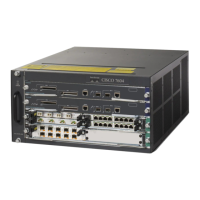Send document comments to nexus7k-docfeedback@cisco.com
3-7
Cisco Nexus 7000 Series NX-OS Interfaces Configuration Guide, Release 5.x
OL-23435-03
Chapter 3 Configuring Layer 2 Interfaces
Information About Access and Trunk Interfaces
Note Beginning with Cisco Release 5.2, you can change the block of VLANs reserved for internal use. See
the Cisco Nexus 7000 Series NX-OS Layer 2 Switching Configuration Guide, Release 5.x, for more
information about changing the reserved VLANs.
High Availability
The software supports high availability for Layer 2 ports.
Note See the Cisco Nexus 7000 Series NX-OS High Availability and Redundancy Guide, Release 5.x, for
complete information on high availability features.
Virtualization Support
The device supports virtual device contexts (VDCs).
All ports in the same trunk must be in the same VDC, and trunk ports cannot carry VLANs from different
VDCs.
Note See the Cisco Nexus 7000 Series NX-OS Virtual Device Context Configuration Guide, Release 5.x, for
complete information on VDCs and assigning resources.
Default Interfaces
You can use the default interface feature to clear the configured parameters for both physical and logical
interfaces such as the Ethernet, loopback, VLAN network, tunnel, and the port-channel interface.
Note A maximum of 8 ports can be selected for the default interface. The default interfaces feature is not
supported for management interfaces because the device could go to an unreachable state.
SVI Autostate Exclude
Ordinarily, when a VLAN interface has multiple ports in the VLAN, the SVI will go to the down state
when all the ports in the VLAN go down. You can use the SVI Autostate Exclude feature to exclude
specific ports and port channels while defining the status of the SVI (up or down) even if it belongs to
the same VLAN. For example, even if the excluded port or port channel is in the up state and other ports
are in the down state in the VLAN, the SVI state is changed to down.
Note You can use the SVI Autostate Exclude feature only for switched physical Ethernet ports and port
channels.

